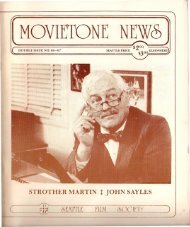MOVIETONE NEW8 . - Parallax View Annex
MOVIETONE NEW8 . - Parallax View Annex
MOVIETONE NEW8 . - Parallax View Annex
Create successful ePaper yourself
Turn your PDF publications into a flip-book with our unique Google optimized e-Paper software.
photos this page: Museum of Modern Art Film Stills Archive.<br />
easy. A sequence detailing the<br />
teacher's opening of gifts from her<br />
now-grown pupils, all of whom she<br />
believes are "successful", counterposes<br />
her description of their young<br />
talents with shots of their present<br />
real-life situations: the class speechmaker<br />
is shown as a struggling lawyer<br />
unable to pay his rent, the would-be<br />
violinist as a soda jerk, the budding<br />
artist as earning drinks by painting<br />
pinups over a bar, and the aspiring<br />
singer idly warbling the film's theme<br />
lament, "I Need a Friend," alone<br />
with only a pianist in a rundown<br />
cafe. Another song, "Hometown,"<br />
catalogues the joys of smalltown<br />
living and impels Frankie to return to<br />
his birthplace; but it is sung in a city<br />
style in a city dive by one of Frankie's<br />
ex-con buddies, who is a city boy<br />
with the most obvious of urban faces<br />
and manners. The touch here, however,<br />
as it is throughout the film, is<br />
distinctively gentle and low-key.<br />
This sure restraint and control<br />
culminates and achieves a homely<br />
eloquence in a scene in which<br />
Frankie returns to his boyhood<br />
home. It is undoubtedly one of the<br />
places where Nugent felt Howard let<br />
his camera "freeze" (though four or<br />
five setups are utilized) and reduced<br />
his narrative "to a series of static<br />
dialogue frames." This type of setpiece,<br />
however, had always been the<br />
basic structural unit of Howard's<br />
visual style. Though his range of<br />
features includes all manner of<br />
camera and editing stylistics (The<br />
Trial of Vivienne Ware, for example,<br />
is a delightful cornucopia of every<br />
possible visual and editing device to<br />
invoke speed-an orchestration of<br />
swish pans, flash cuts, tilts and constantly<br />
varying angles), and though<br />
he was a confessed admirer of Murnau<br />
and could move his camera with<br />
skill and alacrity (especially, as<br />
William K. Everson has pointed out<br />
to me, when he had a cinematographer<br />
such as James Wong Howe<br />
who favored a mobile camera), he<br />
seemed to reserve for his important<br />
7




